1995 CHEVROLET S10 battery
[x] Cancel search: batteryPage 6 of 354
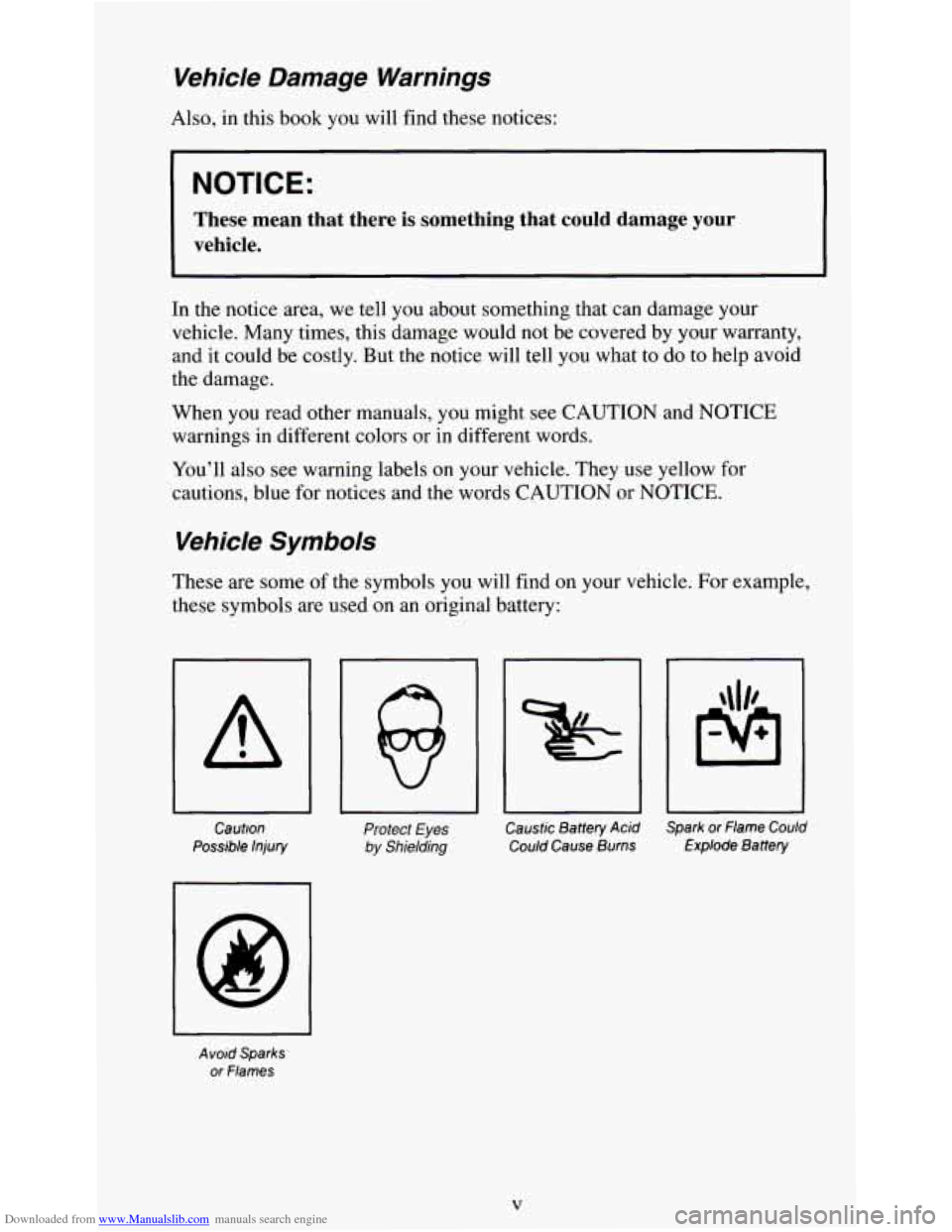
Downloaded from www.Manualslib.com manuals search engine Vehicle Damage Warnings
Also, in this book you will find these notices:
NOTICE:
These mean that there is something that could damage your
vehicle.
In the notice area, we tell you about something that can damage your
vehicle. Many times,
this damage would not be covered by your warranty,
and it could be costly. But
the notice will tell you what to do to help avoid
the damage.
When you read other manuals, you might see CAUTION and NOTICE
warnings in different colors
or in different words.
You’ll also see warning labels on your vehicle. They use yellow for
cautions, blue
for notices and the words CAUTION or NOTICE.
Vehicle Symbols
These are some of the symbols you will find on your vehicle. For example,
these symbols are used on an original battery:
Cautron Protect Eyes Caustic Battery Acid Spark or Flame Could
Possible Injury
by Shielding Could Cause Burns Explode Battery
Avoid
Sparks
or Flames
V
Page 8 of 354
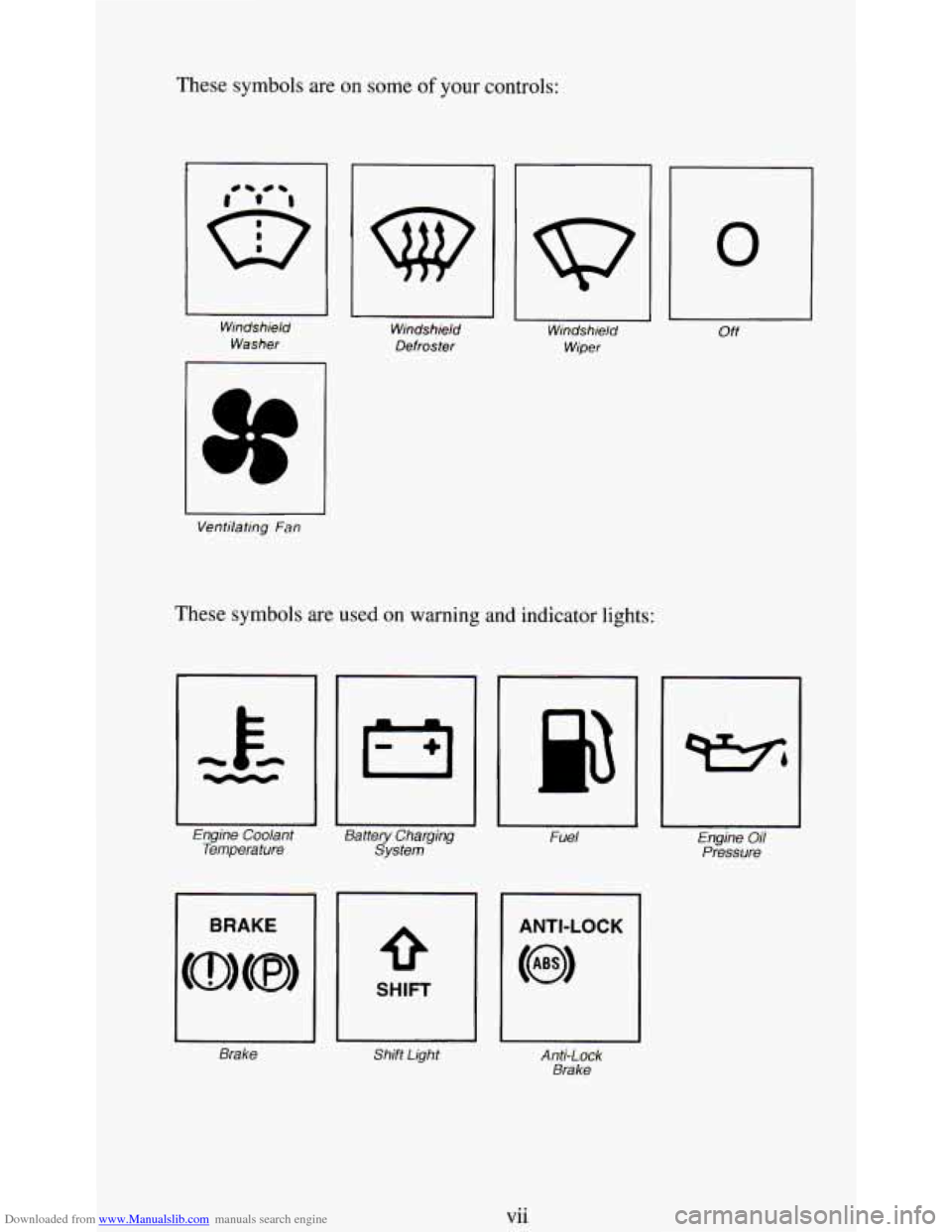
Downloaded from www.Manualslib.com manuals search engine These symbols are on some of your controls:
Windshield
Washer Windshield
Defroster Windshield
Wiper
Ventilating
Fan
These symbols are used on warning and indicator lights:
Engine Coolant Battery Charging Fuel Temperature System
SHIFT
Brake Shift Light Anti-Lock
Brake
0
Off
Engine Oil
Pressure
vi i
Page 29 of 354

Downloaded from www.Manualslib.com manuals search engine Your vehicle is equipped with a diagnostic module, which records
information about the air bag system. The module records information
about the readiness
of the system, when the sensors are activated and
driver’s safety belt usage at deployment.
Let only qualified technicians work on your air bag system. Improper
service can mean that your air bag system won’t work properly. See
your dealer for service.
NOTICE:
If you damage the cover for the driver’s air bag, it may not work
properly. You may have to replace the air bag module.
Do not
open or break the air bag cover.
Servicing Your Air Bag-Equipped Vehicle
The air bag affects how your vehicle should be serviced. There are parts of
the air
bag system in several places around your vehicle. You don’t want the
system to inflate while someone is working
on your vehicle. Your GM
dealer and the
1995 GM Service Manual have information about servicing
your vehicle and the air bag system. To purchase a service manual, see
“Service Publications” in the Index. The air bag system does not need
regular maintenance.
I A CAUTION:
For up to 2 minutes after the ignition key is turned off and the
battery
is disconnected, an air bag can still inflate during
improper service. You can be injured
if you are close to an air
bag when,it inflates. Avoid wires wrapped with yellow tape, or
yellow connectors. They are probably part
of the air bag system.
Be sure to follow proper service procedures, and make sure the
person performing work for you is qualified to do
so.
1-20
Page 52 of 354
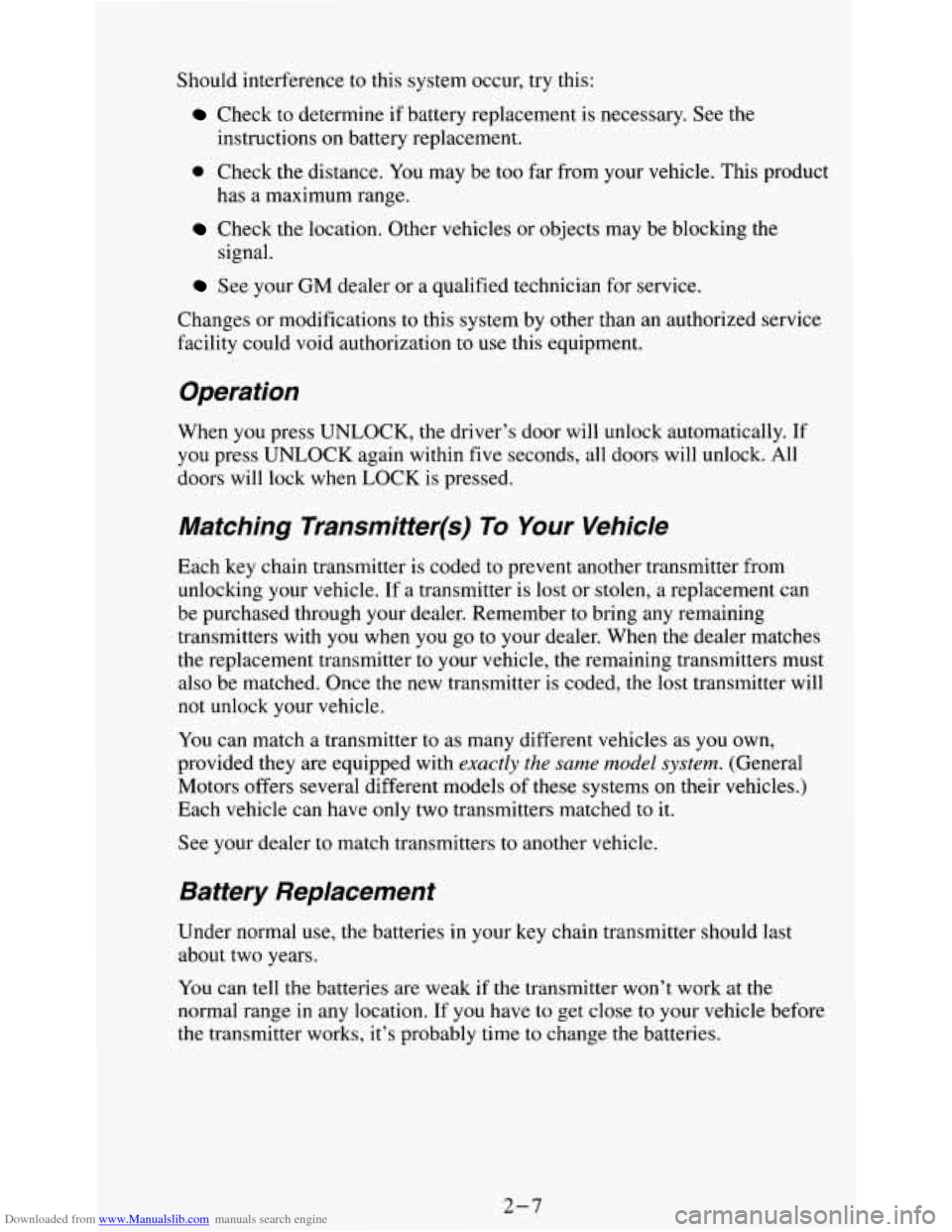
Downloaded from www.Manualslib.com manuals search engine Should interference to this system occur, try this:
Check to determine if battery replacement is necessary. See the
instructions
on battery replacement.
0 Check the distance. You may be too far from your vehicle. This product
has a maximum range.
Check the location. Other vehicles or objects may be blocking the
See your GM dealer or a qualified technician for service.
signal.
Changes or modifications to this system by other than an authorized service
facility could void authorization to
use this equipment.
Operation
When you press UNLOCK, the driver’s door will unlock automatically. If
you press UNLOCK again within five seconds,
all doors will unlock. All
doors will lock when LOCK is pressed.
Matching Transmitter(s) To Your Vehicle
Each key chain transmitter is coded to prevent another transmitter from
unlocking your vehicle. If a transmitter is lost or stolen, a replacement can
be purchased through your dealer. Remember to bring any remaining
transmitters with you when you go to your dealer. When the dealer matches
the replacement transmitter to your vehicle, the remaining transmitters must
also be matched. Once the new transmitter is coded, the lost transmitter will
not unlock your vehicle.
You can match a transmitter to as many different vehicles as you own,
provided they
are equipped with exactly the same model system. (General
Motors offers several different models
of these systems on their vehicles.)
Each vehicle can have only two transmitters matched to
it.
See your dealer to match transmitters to another vehicle.
Battery Replacement
Under normal use, the batteries in your key chain transmitter should last
about two years.
You can tell the batteries are weak if the transmitter won’t work at the
normal range in any location. If you have to get close to your vehicle before
the transmitter works, it’s probably time to change the batteries.
2-7
Page 53 of 354
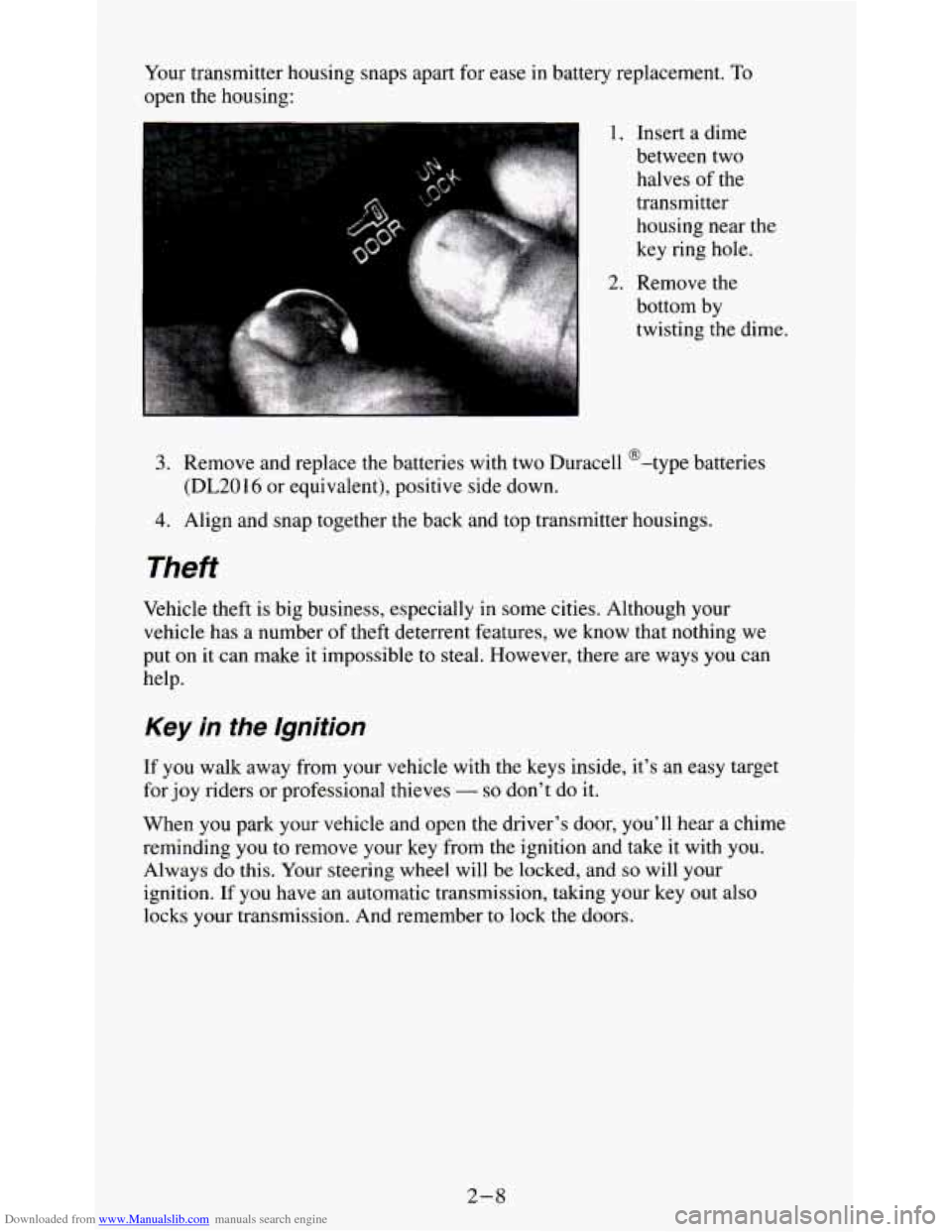
Downloaded from www.Manualslib.com manuals search engine Your transmitter housing snaps apart for ease in battery replacement. To
open the housing:
1. Insert a dime
between two
halves
of the
transmitter
housing near the
key ring hole.
2. Remove the
bottom by
twisting the dime.
3. Remove and replace the batteries with two Duracell @-type batteries
4. Align and snap together the back and top transmitter housings.
(DL2016
or equivalent), positive side down.
Theft
Vehicle theft is big business, especially in some cities. Although your
vehicle has a number
of theft deterrent features, we know that nothing we
put
on it can make it impossible to steal. However, there are ways you can
help.
Key in the lgnition
If you walk away from your vehicle with the keys inside, it’s an easy target
for joy riders or professional thieves
- so don’t do it.
When
you park your vehicle and open the driver’s door, you’ll hear a chime
reminding you
to remove your key from the ignition and take it with you.
Always do this. Your steering wheel will be locked, and so will your
ignition.
If you have an automatic transmission, taking your key out also
locks your transmission. And remember
to lock the doors.
2-8
Page 55 of 354
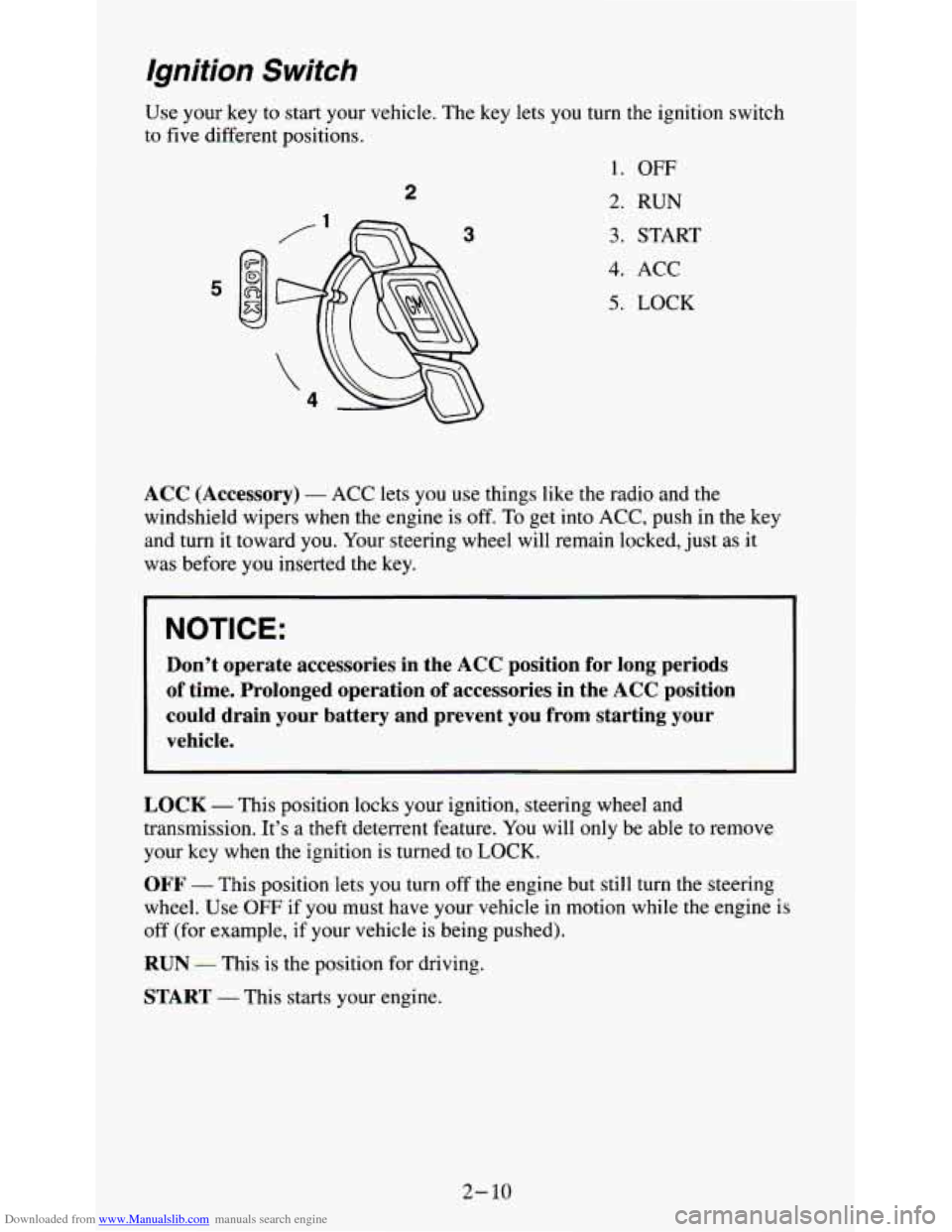
Downloaded from www.Manualslib.com manuals search engine Ignition Switch
2
Use your key to start your vehicle. The key lets you turn the ignition switch
to five different positions.
1.
OFF
2. RUN
3. START
4. ACC
5. LOCK 5
ACC (Accessory) - ACC lets you use things like the radio and the
windshield wipers when the engine is off. To get into ACC, push in the key
and turn it toward
you. Your steering wheel will remain locked, just as it
was before you inserted the key.
Don’t operate accessories in the ACC position for long periods
of time. Prolonged operation
of accessories in the ACC position
could drain your battery and prevent you from starting your
vehicle.
LOCK - This position locks your ignition, steering wheel and
transmission. It’s a theft deterrent feature. You will only
be able to remove
your key when
the ignition is turned to LOCK.
OFF - This position lets you turn off the engine but still turn the steering
wheel. Use
OFF if you must have your vehicle in motion while the engine is
off (for example, if your vehicle
is being pushed).
RUN - This is the position for driving.
START - This starts your engine.
2- 10
Page 57 of 354

Downloaded from www.Manualslib.com manuals search engine To Remove the Key
On manual transmission vehicles, turn the key to the LOCK position while
pressing the key release button down at the same time. Pull the key straight
out.
On automatic transmission vehicles,
turn the key to LOCK and pull it
straight out.
Starting Your Engine
Engines start differently. The 8th digit of your Vehicle Identification
Number (VIN) shows the code letter or number for your engine. You will
find the VIN at the top left
of your instrument panel. (See “Vehicle
Identification Number” in the Index.) Follow the proper steps to start the
engine.
Automatic transmission:
Move your shift lever to PARK (P) or NEUTRAL (N). Your engine won’t
start in any other position
- that’s a safety feature. To restart when you’re
already moving, use NEUTRAL (N) only.
NOTICE:
Don’t try to shift to PARK (P) if your vehicle is moving. If you
do, you could damage the transmission. Shift to PARK (P) only
when your vehicle is stopped.
Manual transmission:
The gear selector should be in neutral. Hold the clutch pedal to the floor and
start the engine. Your vehicle won’t start
if the clutch pedal is not all the
way down
- that’s a safety feature.
To start your 2.2 Liter engine:
1. Without pushing the accelerator pedal, turn your ignition key to
START, When the engine starts, let go of the key. The idle speed will
go down as your engine gets warm.
r
NOTICE:
Holding your key in START for longer than 15 seconds at a time
will cause your battery to be drained much sooner. And the
excessive heat can damage your starter motor.
2- 12
Page 58 of 354

Downloaded from www.Manualslib.com manuals search engine 2. If your engine still won’t start (or starts but then stops), it could be
flooded with too much gasoline. Try pushing your accelerator pedal all
the way to the floor and holding it there as you hold the key in START
again, do the same thing, but this time keep the pedal down for five or
six seconds. This clears the extra gasoline from the engine.
’ for about three seconds. If the vehicle starts briefly but then stops
NOTICE:
Your engine is designed to work with the electronics in your
vehicle.
If you add electrical parts or accessories, you could
change the way the fuel injection system operates. Before adding
electrical equipment, check with your dealer.
If you don’t, your
engine might not perform properly.
If you ever have to have your vehicle towed, see the part of this
manual that tells how
to do it without damaging your vehicle.
See “Towing Your Vehicle” in the Index.
To start your 4.3 Liter Code Z engine:
1. Without pushing the accelerator pedal, turn your ignition key to
START. When the engine starts, let go of the key. The idle speed will
go down as your engine gets warm.
NOTICE:
Holding your key in START for longer than 15 seconds at a time
will cause your battery to be drained much sooner. And the
excessive heat can damage your starter motor.
2. If it doesn’t start right away, hold your key in START. If it doesn’t start
in three seconds, push the accelerator pedal about one-quarter of the
way down for 12 more seconds, or until it starts.
3. If your engine still won’t start (or starts but then stops), it could be
flooded with too much gasoline. Try this:
4. Wait 15 seconds to let the starter motor cool down. Then push your
accelerator pedal all the way to the floor. Hold
it there. Then, hold the
key in
START for no more than ten seconds. This clears the extra
gasoline from the engine.
If the engine still doesn’t start, wait another 15 seconds and do Step 4
again.
When the engine starts, let go
of the key and the accelerator pedal.
2-
13